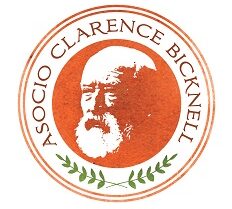Clarence Bicknell, archaeologist. An appreciation, by Christopher Chippindale. In 1909, the senior French prehistorian Cartailhac paid Bicknell a visit. He was greatly interested by his long day’s excursion into the Val Fontanalba. The rocks were much more wonderful than he had expected; and he said. “It is a great mystery.” His antiquarian colleagues had previously escaped into Carthaginian fantasies. In study of the Merviglie today, one sees emphasis on a thorough field search, on a meticulous field record and inventory, on classification, and on considered inference from studious observation in the field  and comparative analysis of the record. In short, Bicknell’s efforts make his work the model for work a century later.
and comparative analysis of the record. In short, Bicknell’s efforts make his work the model for work a century later.
Why is this so? The truth is that the then professionals had no technique to study the art, beyond what Bicknell worked out for himself. Professor Arturo Issel gave over a large portion of his large prehistory of Liguria (1903) to an account of the figures. Bicknell called this the “most important and comprehensive contribution to the subject yet written”. In comparing Bicknell’s writing with Issel’s, it is striking how strong the “amateur” is in its systematic observation on the ground. By contrast the “professional” is weak in its striking preference for unverifiable speculation as to motives, meaning and authorship. Issel – though he wrote 70 pages on the subject – had seen very few figures himself. For the most part Bicknell was disappointed when the experts did not come to his mountain; if they did, then so briefly. The first compatriot British archaeologist to see them was Miles Burkitt, as late as 1929! But perhaps they had no need to go; Déchelette’s great Manuel d’Archéologie (1910) provides a sufficiently large and good account, entirely from Bicknell’s publications, and can date the figures securely to its Bronze Age period I.
Right: first known photograph of Le Sorcier, rock engraving in the Vallée des Merveilles. The hand-written label reads “Classe II, 326, L.Pollini (Amateur) Figure Preistoriche Nel Vallone delle Miraviglie”. Luigi Pollini was Clarence Bicknell’s faithful colleague and right-hand-man.
 The story of archaeology in 19th Century Europe is the giving-up of habits drawn from history and antiquarian studies in favour of different methods owing allegiance to natural history and observational science. Where speculations had drawn on ancient authors, using them to guess at ancient ethnicities, the new archaeology found better models in the field sciences, in the stratigraphic methods of the geologists, and in the classifying systems of the natural historians. Instead of supposing Phoenicians or Carthaginians or Hittites or Egyptians, which the antiquarians did for Monte Bego as they did across ancient Europe, Bicknell worked in the spirit of the discipline he knew, that of field botany. In prehistory, it turned out, the apparatus of antiquarian wisdom was more than an irrelevance; it was an actual, and often considerable, obstacle.
The story of archaeology in 19th Century Europe is the giving-up of habits drawn from history and antiquarian studies in favour of different methods owing allegiance to natural history and observational science. Where speculations had drawn on ancient authors, using them to guess at ancient ethnicities, the new archaeology found better models in the field sciences, in the stratigraphic methods of the geologists, and in the classifying systems of the natural historians. Instead of supposing Phoenicians or Carthaginians or Hittites or Egyptians, which the antiquarians did for Monte Bego as they did across ancient Europe, Bicknell worked in the spirit of the discipline he knew, that of field botany. In prehistory, it turned out, the apparatus of antiquarian wisdom was more than an irrelevance; it was an actual, and often considerable, obstacle.
Left: Clarence on the Chiappes de Fontanalba, a valley of flat rock face ideal for early man’s rock eangraving
The chief reason for the high quality of Bicknell’s work was his ignorance of what a professional would do to study the art. One can see much the same course of events in the slow acceptance, not many years before, of an ancient date for the Ice Age paintings in the deep French and Spanish caves, where the guess that fine images could not be very ancient was overwhelmed by the geological demonstration of their prehistoric context. Where Bicknell thought himself only an amateur in these matters, in truth his were the requisite skills.
Reproduced from the chapter “A New Science of Archaeology” pp44-45 of Chippindale’s “A High Way to Heaven” (1998) with the author’s consent. Christopher Chippindale (born 13 October 1951) is a British archaeologist. He worked until 2013 at the University of Cambridge Museum of Archaeology and Anthropology. He is also the author of the book Stonehenge Complete, published in 2004, and many other papers. See also “Una Vita Sacra: Clarence Bicknell and the Discovery of Alpine Prehistoric Rock Art” (Papers in Italian Archaeology 1985) available from http://www.barpublishing.com/ of which there is an excerpt here.
 |  |  |

